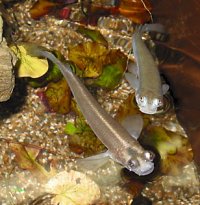![]()
![]()
|
Believe It or Not! Four-Eyed Fish By Frank M. Greco
Hailing from Trinidad and Venezuela to the Amazon delta in Brazil, Anableps are mainly found in freshwater habitats, but also inhabit the brackish parts of lagoons and mangrove coastlines. They feed mainly on insects that fall into the water, as well as small aquatic invertebrates and diatoms living on the mud bottom. They can also catch and eat small fishes, so keep that in mind when considering tank mates! 
Keeping Anableps in a hobbyist's tank is an easy task, although they will need a large tank as this fish grows to a foot long. Since they are a schooling fish, you'll want to keep a minimum of four, so a tank size of 75 gallons minimum is advised. I've found that keeping them in a brackish-water environment is preferable to keeping them in straight freshwater. The addition of 1/3 pound of marine salt per 10 gallons will make the water brackish enough for these fish. As a substrate, you'll want to use something that buffers the water. Aragonite sand is the best choice as these fish like to root around in the substrate from time to time, especially if kept in a shallow tank. If this material can't be found, fine aragonite gravel will be a good substitute. Feeding these four-eyed fish is a snap; they're not fussy. Frozen foods such as mysis shrimp are readily accepted, as are prepared foods such as pelleted and freeze-dried diets. Anableps also enjoy live wingless fruit flies and even pinhead crickets. Provide lots of plants (both floating and anchored) for the fish to hide in, as males can be aggressive towards each other. And you'll want to keep the tank well-covered, as these fish are excellent jumpers and can (and have) jumped right out of many an astonished keeper's tank. Suitable tank mates for these fish include any number of brackish-water species, including fingerfish (Monodactylus), Mollies, Mudskippers, Indian Anableps (not a true Anableps, but rather a mullet that fills the same niche as Anableps), and the like. Just remember, they can and will eat fish smaller than themselves.
So Baby, Are You a Lefty or a Righty?
There is one other thing that is unusual about these four-eyed fish other than the jumping out of the tank and growing up to a foot long. They are members of a family of fishes call Anablepidae, also known as one-sided livebearers. (Oh, I didn't mention they produce live young, did I?) Like other livebearers, the male possesses a gonopodium, the organ by which sperm is inserted into the female's genital opening (foricula). However, the gonopodium swings only one way, unlike other livebearers. This means that a 'right handed' male can mate only with a 'left-handed female. Why this is so is not known, but it does add to the 'unusuality' of this fish, as if split eyes weren't enough! After a gestation of about three-months, 3-10 (more if the female is large) 1.5 inch babies are born. They are able to fend for themselves, and will eat the same food as the parents. There are many wonderful unusual fish out there, but I think it's safe to say you'd be hard-pressed to find one more unusual than the four-eyed fish, Anableps. Frank M. Greco is a long-time hobbyist and the Senior Aquarist at the New York Aquarium. Visit him on the web at www.franksaquarium.com, or send your fish questions to Frank at newyorktails@aol.com. He may answer it in his next column! |
Would you like to be notified when New York Tails updates its Web site with articles about pets and issues of interest to pet owners? Click here to send us e-mail. Enter "New York Tails Updates" as the subject of the e-mail.